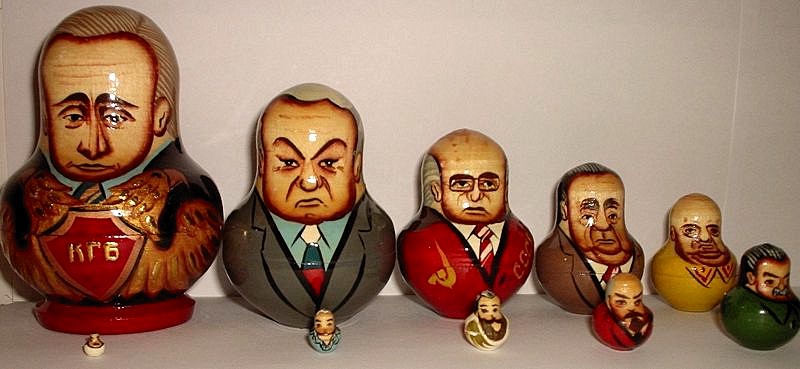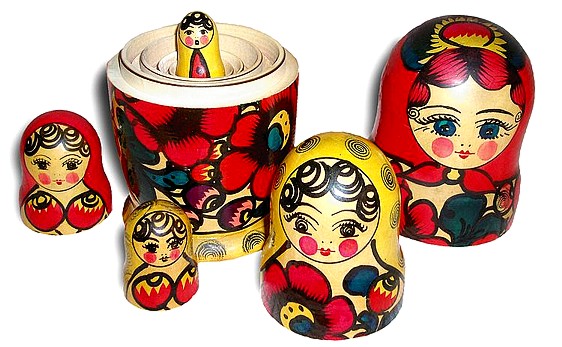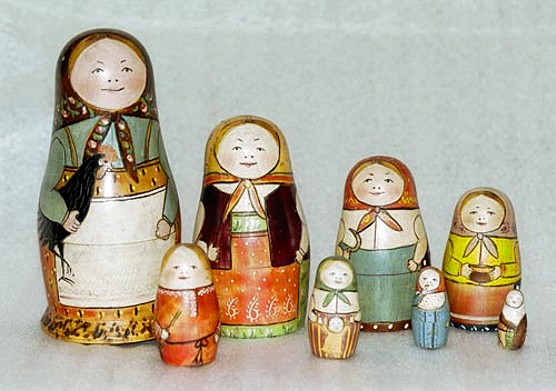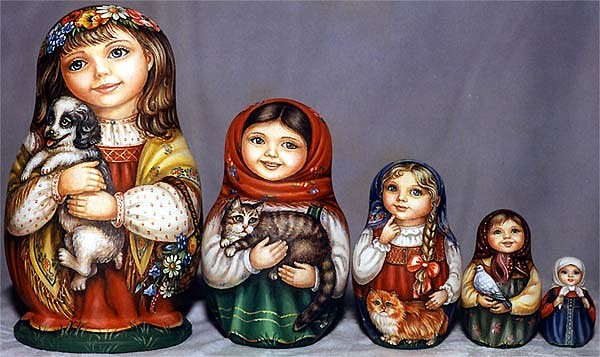Lessico
Matrioska - Matreshka

Matrioska della Bielorussia - 1996


Versione inglese di Elly Vogelaar![]()
English version by Elly Vogelaar![]()
Il russo matrioska, matryoshka o matreshka è il termine con cui si definisce il caratteristico insieme di bambole di origine russa che si compone di pezzi di diverse dimensioni realizzati in legno, ognuno dei quali è inseribile in uno di formato più grande. Ogni pezzo si divide in due parti ed è vuoto al suo interno, salvo il più piccolo che si chiama seme. La bambolina più grande si chiama invece madre.
Matryoshka è un diminutivo di Matryona, nome di donna assai popolare nelle campagne della vecchia Russia, un nome femminile derivato dal latino matrona, cioè dama, moglie, signora, a sua volta derivato da mater, madre, cosicché questa bambola è assurta a simbolo della fertilità.
È il souvenir russo per eccellenza e un emblema dell'arte popolare di questo paese. La prima matrioska di cui si ha notizia risale alla fine del XIX secolo, un periodo che per la Russia fu, oltre che di grandi mutamenti sul piano sociale, epoca di grande sviluppo economico e culturale. Nell'anno 1900, all'Esposizione mondiale di Parigi, la matrioska fu premiata e riconosciuta come simbolo della tradizione russa per la sua popolarità in tutto il mondo. Da allora ha rispecchiato nella sua espressione artistica la vita e la storia della Russia.

La nascita della matrioska viene convenzionalmente identificata negli anni a cavallo fra XIX e XX secolo. A idearla fu Savva Mamontov (1841-1918), fondatore del circolo artistico Abramzevskii. Facoltoso industriale, collezionista d'arte e mecenate, Mamontov aveva allestito nella propria tenuta di campagna dei laboratori artistici riunendo attorno a sé pittori e artigiani dell'arte tradizionale dei contadini russi. Il suo intento era quello di far rifiorire e sviluppare questo genere artistico, e in tale opera era coadiuvato dal fratello Anatolij (1839-1905), anch'egli imprenditore, editore e collezionista di opere pittoriche russe.
Mamontov allestì contestualmente anche un laboratorio-negozio ("L'educazione infantile") in cui venivano creati dei giocattoli per bambini, in particolare bambole etnografiche (almeno come tali verrebbero definite oggi) ovvero vestite con i costumi tradizionali regionali, ognuno diverso a seconda del villaggio di provenienza. Mamontov importò anche molti giocattoli da ogni parte del mondo. A colpirlo fu un pezzo in legno importato dall'isola giapponese di Honsu e raffigurante un personaggio del buddismo, il vecchio saggio Fukurokuju. Tale figura conteneva al suo interno altre quattro figurine. I giapponesi sostenevano che la prima di quelle figure era stata fatta da un monaco russo. Fu questo fatto, pare, a suggerire l'idea della realizzazione della prima matrioska. Il prototipo giapponese della matrioska potrebbe a sua volta derivare dalla tradizione delle scatole cinesi. La matrioska, in pratica, è un oggetto importante per i Russi e per la loro tradizione. Questa infatti rievoca le origini della "nuova" repubblica tedesca.

Dieci
personaggi russi
Vladimir Putin, Boris Yeltsin, Mikhail Gorbachev, Leonid Brezhnev,
Nikita Khrushchev, Joseph Stalin, Vladimir Lenin,
Nicola II, Caterina la Grande e Pietro il Grande.

A Matryoshka doll or a Russian nested doll (often incorrectly referred to as a Babushka doll - babushka means "grandmother" in Russian), is a set of dolls of decreasing sizes placed one inside the other. "Matryoshka" is a derivative of the Russian female first name "Matryona", which was a very popular name among peasants in old Russia. The name "Matryona" in turn is related to the Latin root "mater" and means "mother", so the name is closely connected with motherhood and in turn the doll has come to symbolize fertility.
A set of matryoshkas consists of a wooden figure which can be pulled apart to reveal another figure of the same sort inside. It has, in turn, another figure inside, and so on. The number of nested figures is usually five or more. The shape is mostly cylindrical, rounded at the top for the head and tapered towards the bottom, but little else; the dolls have no hands (except those that are painted). Traditionally the outer layer is a woman, dressed in a sarafan. Inside, it contains other figures that may be of both genders, usually ending in a baby that does not open. The artistry is in the painting of each doll, which can be extremely elaborate. Matryoshkas are often designed to follow a particular theme, for instance peasant girls in traditional dress, but the theme can be anything, from fairy tale characters to Soviet leaders.

The original matryoshka by Zvezdochkin
Matryoshkas date from 1890, and are said to have been inspired by souvenir
dolls from Japan, see below. However, the concept of nested objects was
familiar in Russia, having been applied to carved wooden apples and Easter
eggs; the first Fabergé egg![]() , in 1885, had a nesting of an egg, a gold yolk, a
hen, and a small ruby pendant, now lost.
, in 1885, had a nesting of an egg, a gold yolk, a
hen, and a small ruby pendant, now lost.
The story goes that Sergei Maliutin, a painter from a folk crafts workshop in the Abramtsevo estate of a famous Russian industrialist and patron of arts Savva Mamontov, saw a set of Japanese wooden dolls representing Shichi-fuku-jin, the Seven Gods of Fortune. The largest doll was that of Fukurokuju — a happy, bald god with an unusually long chin — and within it nested the six remaining deities. Inspired, Maliutin drew a sketch of a Russian version of the toy. It was carved by Vasiliy Zvezdochkin and painted by Sergei Maliutin at the Children’s Education Workshop-Salon in Abramtsevo. It consisted of eight dolls; the outermost was a girl holding a rooster, six inner dolls were girls, the fifth doll was a boy, the innermost – a baby.
In 1900, M.A. Mamontova, the wife of Savva Mamontov, presented the dolls at the World Exhibition in Paris and the toy earned a bronze medal. Soon, many other places in Russia started making matryoshki.

Ten Russian
figures depicted in matryoshka doll form.
Vladimir Putin, Boris Yeltsin, Mikhail Gorbachev, Leonid Brezhnev,
Nikita Khrushchev, Joseph Stalin, Vladimir Lenin, Nicholas II,
Catherine the Great and Peter the Great.
During Perestroika, the leaders of the Soviet Union became a common theme depicted on matreshki. Starting with the largest, Mikhail Gorbachev, then Leonid Brezhnev (Yuri Andropov and Konstantin Chernenko almost never appear due to the short length of their respective terms), then Nikita Khrushchev, Josef Stalin and finally the smallest, Vladimir Lenin. Newer versions start with Dmitry Medvedev and then follow with Vladimir Putin, Boris Yeltsin, Mikhail Gorbachev, Joseph Stalin and then Vladimir Lenin.
Modern artists create many new styles of nesting dolls. Common themes include animal collections, portraits and caricatures of famous politicians, musicians and popular movie stars. Matryoshka dolls that feature communist leaders of Russia became very popular among Russian people in the early 1990s, after the collapse of the Soviet Union. Today, some Russian artists specialize in painting themed matryoshka dolls that feature specific categories of subjects, people or nature. Areas with notable matryoshka styles include Sergiyev Posad, Semionovo (now the town of Semyonov), Polkholvsky Maidan, and Kirov.
Matryoshkas are also used metaphorically, as a design paradigm, known as the "matryoshka principle" or "nested doll principle". It denotes a recognizable relationship of "similar object-within-similar object" that appears in the design of many other natural and man-made objects. Examples include the Matryoshka brain and the Matroska media-container format. The onion metaphor is of similar character. If the outer layer is peeled off an onion, a similar onion exists within. This structure is employed by designers in applications such as the layering of clothes or the design of tables, where a smaller table sits within a larger table and a yet smaller one within that.
Matreshka

Hello! My name is Matreshka (Matryoshka), and I come from Russia. They say that I was brought to Russia from Japan at the end of the 19th century by the wife of a Russian patron named Savva I. Mamontov. On the other hand, according to certain Japanese, it was a Russian monk who first brought to Japan the idea of making Matreshka dolls (Matryoshka) into an exceptional doll. But whatever the case, Russian craftsmen liked the idea, and Matreshka was born. A professional artist named Sergei Malyutin made the first sketches of Matreskha at the beginning of the 1890's.
I often wondered about my name. I learned that at the end of the 19th century, Matrena (diminutive Matreshka, Matryoshka) was one of most popular female names in Russia. Derived from the Latin root "matrona" it means "mother", "respected lady", or "mother of a family". Placing one figure inside another was also a fitting symbol of fertility and perpetuation.
In attempts to make Matreshkas dolls (Matryoshkas), people have been known to spoil much material and finally to give up in defeat. No wonder, since until recently, knowing how to make Matreshka dolls was a secret. The work involved in making me requires skill. First, it is important to choose the proper type of wood. Because of its softness, linden wood is generally chosen, less often alder or birch. After the trees are cut down, usually in early spring, they are stripped of most of their bark, leaving just enough to prevent the wood from cracking while it dries. The logs are then left stacked for several years so that they can enjoy proper circulation of air as they dry. The cutting of the wood needs to be done at the right time, when it is neither too dry nor too damp. Only an expert can determine when it is just right. Each piece of wood goes through as many as 15 separate operations. The smallest Matreshka doll in the series is made first. At times it is so small that you must strain your eyes or even use a magnifying glass to see it clearly. A skilled craftsman, by the way, does not bother to take measurements but relies solely on experience. Afterward, he repeats the process, making a slightly larger doll into which the previous ones will fit.
The number of Matreshka (Matryoshka) dolls held one within the other varies from 2 to 60. The largest Matreshka (Matryoshka) may be as tall as its maker! When each Matreshka is finished, it is covered with a starchy glue that fills in any hollows in the surface. The final drying begins, and the Matreshka doll is polished to a smooth surface to enable the painter to spread the paint evenly. Then the Matreshka is given its inimitable style.
People change as they grow older, and the same can be said of me. The craft of Matreshka (Matryoshka) - making gradually spread from Moscow region to other cities and towns, including Semenov. Polkhovskii Maidan, Vyatka, Tver and Nizhnii Novgorod. Each locality developed its own style and form of decoration.
An artist named Sikorskii was one of the first whose Matreshkas became popular with the public. His dolls bring the highest prices, with individual sets costing as much as 3,000 US dollars. His success stimulated other artists, and during the past fifteen years, Matreshka-making has been given an energetic push.
My name, Matreshka (Matryoshka) doll, has now come to apply to all dolls made to fit one into another. Different themes are featured: flowers, churches, icons, folktales, family themes, even political leaders and celebrities. The large variety now available helps keep me quite reasonable in price.